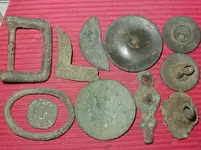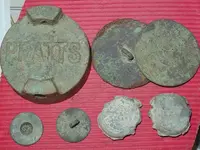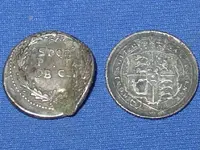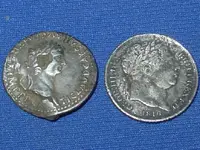CRUSADER
Emerald Member
We started the day by finishing off the last of the 2 acre set-a-side which took us 3 hours. It was a bit of a let down & we only had a broken medieval sword belt hook & a Rose Farthing to speak of. At this point it was heading towards our worst day this year, but we had an after Lunch plan;
We moved to the first Winter Barley field that had been harvested 9 days earlier than expected. (07 July) The field I wanted to try had been scouted by us before with zero results but I just wanted another go of it before we crossed it off. I was kind of hoping for a couple of scrappies as it was close to a major Roman Road. Our tactic on this field is what I call loose gridding; leaving a 2 swing gap between each of us, & look out for a hotspot. 30 minutes in I could tell we were wasting our time & instead of doing a full distance run, I turned early thinking ''sod this field, theirs nothing down here''. After turning 90 degrees & swinging a couple of times I got a got hit. (Roman Silver plated Fouree) We gridded this area with nothing else but a couple of buttons.
(Roman Silver plated Fouree) We gridded this area with nothing else but a couple of buttons.
We then finished in the next field after about 1.5 hours with Cru'dad getting his only good find of the day with minutes to spare;
1816 Sixpence.
Claudius Plated Denarius AD50-51 (R3 rating, although that's for a real one)
Cru'dad's thoughts;
''This coin is dated as AD50-51 due to legend and appears to have been forged using ‘Official Dies’ which was common practice during Claudius’ later years when as the mint had moved from Lyons to Rome. However, Bankers of the day would have been suspicious due to weight (2.35gm) and die axis (2 O’Clock for this coin). Their means of checking was to punch into the coin to see if solid silver which this shows signs of. The plough has also bent and revealed the plating too. An original in this EF condition undamaged would be worth $2,800 book value in Sears Edition 1 printed 2000.''
I think we had both accepted this was going to be a slow day.
We moved to the first Winter Barley field that had been harvested 9 days earlier than expected. (07 July) The field I wanted to try had been scouted by us before with zero results but I just wanted another go of it before we crossed it off. I was kind of hoping for a couple of scrappies as it was close to a major Roman Road. Our tactic on this field is what I call loose gridding; leaving a 2 swing gap between each of us, & look out for a hotspot. 30 minutes in I could tell we were wasting our time & instead of doing a full distance run, I turned early thinking ''sod this field, theirs nothing down here''. After turning 90 degrees & swinging a couple of times I got a got hit.
 (Roman Silver plated Fouree) We gridded this area with nothing else but a couple of buttons.
(Roman Silver plated Fouree) We gridded this area with nothing else but a couple of buttons.We then finished in the next field after about 1.5 hours with Cru'dad getting his only good find of the day with minutes to spare;
1816 Sixpence.
Claudius Plated Denarius AD50-51 (R3 rating, although that's for a real one)
Cru'dad's thoughts;
''This coin is dated as AD50-51 due to legend and appears to have been forged using ‘Official Dies’ which was common practice during Claudius’ later years when as the mint had moved from Lyons to Rome. However, Bankers of the day would have been suspicious due to weight (2.35gm) and die axis (2 O’Clock for this coin). Their means of checking was to punch into the coin to see if solid silver which this shows signs of. The plough has also bent and revealed the plating too. An original in this EF condition undamaged would be worth $2,800 book value in Sears Edition 1 printed 2000.''
I think we had both accepted this was going to be a slow day.

Attachments
Last edited:
Upvote
39









